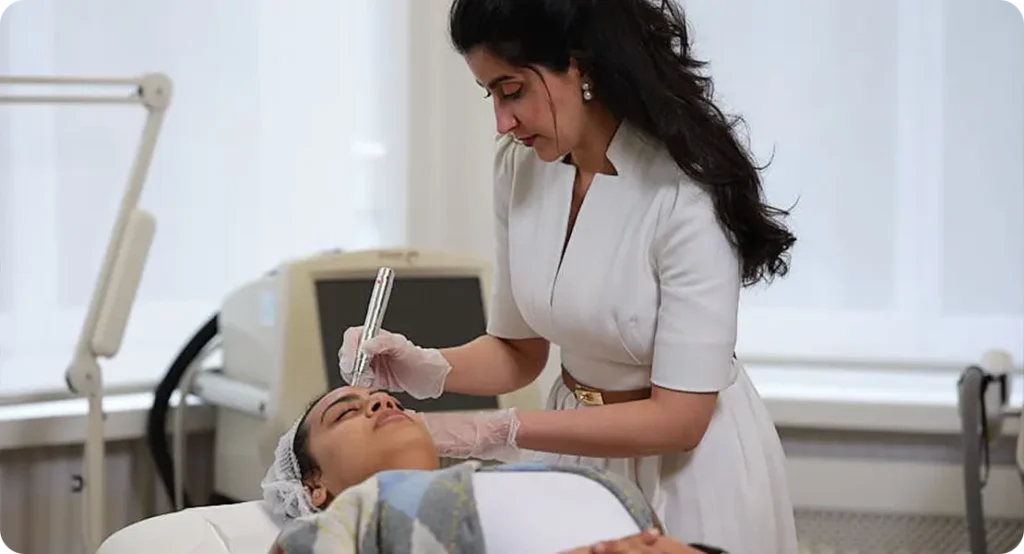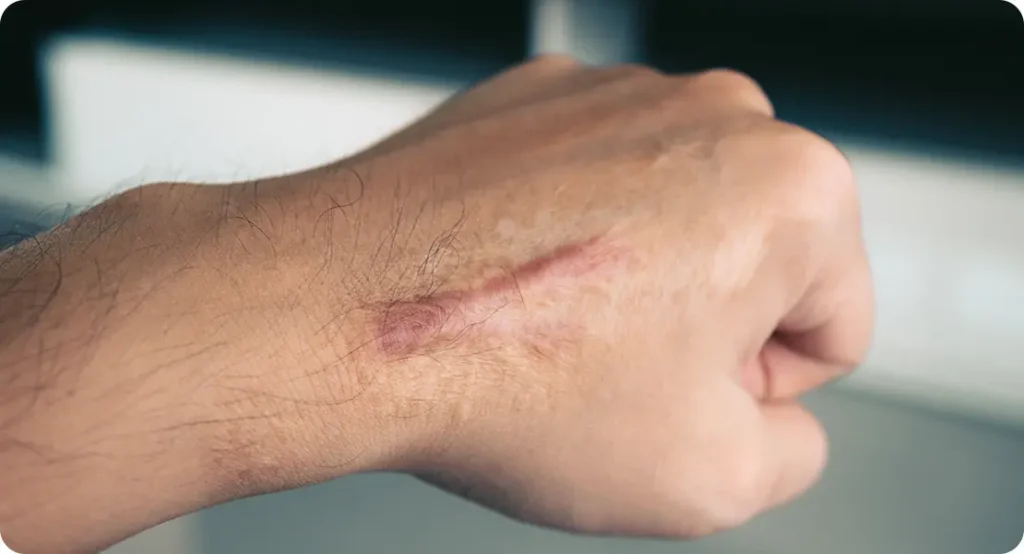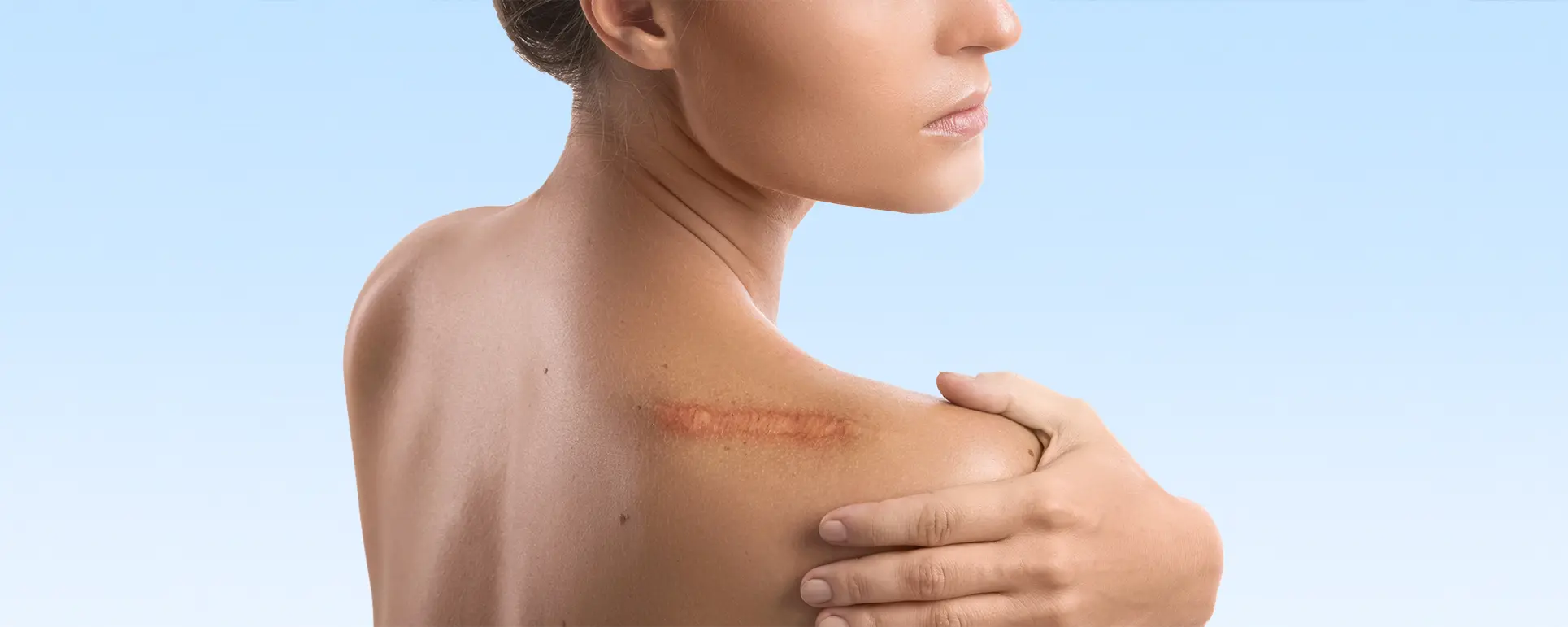Scars can feel like an unwanted reminder of the past whether they came from stubborn acne during your teen years, an unexpected surgery, a C-section, a kitchen accident, or even a growth spurt that left behind stretch marks. Long after the wound has healed, scars often remain visible, and with them can come a mix of frustration, self-consciousness, and questions: Will this ever fade? Should I keep hiding it? Is there anything that really works?
You’re not alone in wanting smoother, more even skin. Whether it’s pitted acne scars on your cheeks, raised keloids on your shoulders, dark marks that just won’t lighten, or silvery lines across your thighs, many people feel overwhelmed by how persistent scars can be and unsure of where to start.
There’s no shortage of products promising overnight results or miracle fixes. A quick search online leads to creams, oils, gadgets, and home hacks, all claiming to erase scars effortlessly. But the truth? Most scars need time, patience, and the right approach to improve especially if you want results that are noticeable and lasting.
That’s where science-backed, dermatologist-recommended methods come in. In this comprehensive guide, we’ll explore the most effective scar treatments available today. From in-clinic procedures like microneedling and laser therapy to powerful at-home routines with ingredients like retinoids and vitamin C, you’ll learn what really works and what’s just marketing hype.
No false promises here just clear, honest guidance to help you take control of your skincare journey. Whether you want to fade a scar that’s years old or tackle a recent mark early, this guide will give you the tools and confidence to move forward.
Because you shouldn’t have to keep covering up your scars. You deserve to feel comfortable in your skin again.
Understanding Scars: What Are You Really Dealing With?
Before you can choose the right scar treatment, it’s essential to understand what kind of scar you’re dealing with. Not all scars are created equal. The way a scar looks and behaves depends on factors like the original injury, your skin type, how your body heals, and even your genetics. That’s why no single treatment works for every scar and why identifying the type of scar you have is the first step to finding a solution that works.
Here’s a breakdown of the main types of scars and what sets them apart:
- Atrophic Scars:
These are the sunken or depressed scars that form when your skin doesn’t produce enough collagen during the healing process. They’re most seen after conditions like acne or chickenpox. There are a few different subtypes of atrophic scars:- Ice pick scars: Deep, narrow scars that look like small holes.
- Boxcar scars: Wider and more defined edges like small craters.
- Rolling scars: Wave-like depressions caused by bands of scar tissue under the skin.
These types of scars usually benefit from treatments that stimulate collagen production, like microneedling, chemical peels, or laser resurfacing.
- Hypertrophic Scars:
These are raised scars that stay within the boundaries of the original wound. They occur when your body produces too much collagen during healing, leading to thick, bumpy areas of skin. They’re often red or pink in colour and can become itchy or uncomfortable.
Hypertrophic scars may improve over time on their own, but targeted treatments like silicone sheets, steroid injections, or laser therapy can help flatten and soften their appearance faster. - Keloid Scars:
Like hypertrophic scars, keloids are also raised but they go beyond the borders of the original wound, spreading into the surrounding healthy skin. They’re often more noticeable and can continue to grow over time. Keloids are more common in people with darker skin tones and can be difficult to treat.
Treatment options include corticosteroid injections, cryotherapy (freezing), pressure therapy, or even surgical removal though recurrence is possible without ongoing care. - Contracture Scars:
These scars usually form after a burn injury, especially if the burn was deep. As the skin tightens during healing, it can pull surrounding tissue, sometimes limiting movement especially if located near joints or over large areas.
Contracture scars often require a combination of physical therapy, surgery, and skin grafting to restore mobility and improve appearance. - Stretch Marks (Striae):
Though not traditionally seen as scars, stretch marks are technically a form of dermal scarring that happens when skin stretches too rapidly such as during puberty, pregnancy, weight gain, or muscle building. These marks usually start off red, purple, or dark brown, then fade to a silvery or pale tone over time.
Treatments like topical retinoids, microneedling, and radiofrequency can help improve their texture and tone.
Topical Ingredients That Actually Work
Many over-the-counter products claim to fade scars but only a few ingredients have consistent research to back them up:
- Silicone Gel or Sheets: Often used for surgical or hypertrophic scars. Silicone hydrates the scar tissue and helps flatten and soften it over time.
- Retinoids (Retinol, Tretinoin): Vitamin A derivatives that encourage skin turnover and collagen production, effective for acne scars and stretch marks.
- Vitamin C (Ascorbic Acid): A brightening agent that reduces pigmentation and improves overall skin tone.
- Niacinamide: Helps with inflammation and pigmentation, particularly in post-acne marks.
- Alpha Hydroxy Acids (AHAs): Gently exfoliate the skin, making scars look less visible over time.
Keep in mind: These treatments require consistency and time results aren’t instant.
Chemical Peels: Rebooting the Skin Surface
When it comes to addressing surface-level scarring, uneven skin tone, and lingering post-acne marks, chemical peels can be a game-changer. This dermatologist-performed treatment involves the application of a chemical solution commonly formulated with active ingredients like glycolic acid, salicylic acid, lactic acid, or trichloroacetic acid (TCA) to exfoliate and remove the damaged outermost layers of skin.
As the treated skin peels away over the following days, it reveals a fresher, smoother, and more even-toned complexion beneath. The intensity of the peel can vary significantly depending on your skin concerns, ranging from light (superficial) peels with minimal downtime to medium and deep peels that may require several days of recovery and aftercare.
Key Benefits of Chemical Peels Include:
- Smoother Skin Texture: By sloughing off dead cells and rough patches, peels help refine the skin’s surface, reducing the visibility of fine lines and minor textural irregularities.
- Fading of Dark Spots and Scars: Chemical exfoliants break up excess pigment in the skin, gradually lightening dark acne scars, hyperpigmentation, and sunspots over a series of treatments.
- Stimulation of New Cell Growth: As the outer layer sheds, the body initiates a healing response, boosting collagen production and encouraging the formation of healthier skin cells.
Peels are customizable based on individual skin type, tolerance, and the severity of the issue being treated. Superficial peels might leave you slightly pink and glowing, while deeper peels require more downtime and may cause visible peeling or flaking for several days. It’s essential to follow pre- and post-treatment care instructions such as avoiding sun exposure and using gentle skincare to ensure optimal results and avoid complications.
Microneedling: Tiny Needles, Big Results

Microneedling, also known as collagen induction therapy, is a minimally invasive skin treatment that has gained popularity for its ability to rejuvenate the skin and fade acne scars. The procedure involves using a device equipped with dozens of fine, sterile needles that create controlled micro-injuries in the skin’s surface. While this might sound intense, these micro-punctures are shallow and typically well tolerated with the help of a topical numbing cream.
These tiny injuries stimulate the skin’s natural healing process, leading to increased production of collagen and elastin proteins essential for maintaining youthful, firm, and smooth skin. The result is a gradual but noticeable improvement in texture, tone, and the visibility of scars over time.
Microneedling can be further enhanced by applying targeted serums during or after the procedure. Popular options include hyaluronic acid (for deep hydration), vitamin C (for brightening and antioxidant support), and platelet-rich plasma (PRP), which uses components from your own blood to speed up healing and amplify results.
Key Benefits of Microneedling Include:
- Reduction in Atrophic Acne Scars: These indented scars, often difficult to treat, respond well to the collagen-boosting effects of microneedling.
- Improved Skin Texture and Firmness: The treatment helps refine pores, smooth out uneven skin, and give the skin a plumper, more youthful appearance.
- Minimal Downtime: Most people experience mild redness and swelling for 24–48 hours, like a mild sunburn, making this a low-downtime option for many.
Laser Resurfacing: High-Tech Scar Fading
Laser resurfacing is widely regarded as one of the most advanced and effective treatments for improving the appearance of scars especially acne scars, surgical marks, and pigmentation issues. This high-tech approach works by using concentrated beams of light energy to either remove damaged skin layers, stimulate collagen production, or target pigmentation and blood vessels, depending on the type of laser used.
The treatment is highly customisable and should always be administered by a qualified dermatologist or cosmetic surgeon, as it involves selecting the right laser type and settings based on your skin type, scar severity, and overall treatment goals.
Types of Lasers Commonly Used for Scar Treatment:
- Fractional CO2 Lasers: These are among the most powerful options, often recommended for deep, indented acne scars, surgical scars, and signs of severe sun damage. They work by creating microthermal zones in the skin removing small columns of tissue and triggering a robust collagen remodelling process. This makes the skin smoother and firmer over time. However, CO2 lasers typically involve some downtime, including redness, peeling, and sensitivity lasting from a few days to over a week.
- Erbium (Erya) Lasers: These offer a gentler alternative to CO2 lasers and are primarily used for superficial scars and textural irregularities. Erbium lasers are especially suitable for people with fair to medium skin tones and can produce noticeable improvements with less downtime.
- Pulsed Dye Lasers (PDL): These are the go-to choose for treating raised, red, or vascular scars, such as hypertrophic scars and keloids. PDL works by targeting the blood vessels in the scar tissue, reducing redness and helping to flatten elevated areas over time.
Benefits of Laser Resurfacing Include:
- Visible Reduction in Scar Depth and Discoloration
- Smoother, Firmer Skin with Improved Tone
- Stimulation of Natural Collagen Regeneration
Steroid Injections: Flattening Raised Scars
For people dealing with raised, thickened scars especially hypertrophic scars and keloids corticosteroid injections offer a highly effective, non-surgical option for reducing their size, texture, and discomfort. These types of scars form when the body produces too much collagen during the healing process, resulting in tissue that protrudes above the skin’s surface and may be itchy, painful, or cosmetically distressing.
Steroid injections work by delivering anti-inflammatory corticosteroids, such as triamcinolone, directly into the scar tissue. This suppresses collagen production and reduces inflammation, gradually softening and flattening the scar over a series of treatments.
What to Expect from Treatment:
A dermatologist typically administers steroid injections in monthly intervals, with noticeable improvement often seen after 2–4 sessions. The treatment itself is quick, usually taking just a few minutes, though some mild stinging or tenderness may occur at the injection site.
In some cases, steroid therapy is combined with cryotherapy (freezing the scar to break down excess tissue) or laser treatments (to reduce redness or further smooth the skin). This multi-modal approach can lead to faster, more comprehensive improvement particularly for stubborn keloids.
Benefits of Steroid Injections Include:
- Flattening of Raised, Bulky Scars
- Reduction in Redness and Inflammation
- Relief from Itching, Tenderness, or Discomfort
- Minimally Invasive, In-Clinic Procedure
Dermal Fillers: Instant Volume for Indented Scars
When it comes to treating atrophic scars the indented or sunken scars that often result from moderate to severe acne dermal fillers offer a fast, effective, and non-surgical way to smooth the skin’s surface. These fillers are typically composed of hyaluronic acid (HA), a naturally occurring substance in the body that attracts water and helps maintain skin volume and hydration.
The procedure involves injecting the filler directly into the depressed areas of the skin to “lift” them and bring them more in line with the surrounding skin texture. This creates an immediately smoother and more even appearance. Fillers work particularly well on boxcar scars (wide, shallow depressions with defined edges) and rolling scars (broad, wave-like indentations).
Key Advantages of Dermal Fillers for Scars Include:
- Instant Results: Most patients see a noticeable improvement immediately after treatment.
- Minimal Downtime: The procedure is quick typically completed within 15–30 minutes and most people return to normal activities the same day.
- Non-Permanent and Reversible: Fillers usually last 6 to 12 months, depending on the product used and how your body metabolises it. This makes it a low-risk option for those hesitant about permanent changes.
- Confidence-Boosting: For people who feel self-conscious about facial scars, even temporary improvement can significantly enhance self-esteem and appearance.
Surgery for Scars: When It’s the Best Option

Some scars particularly deep or irregular ones may require surgical revision. A dermatologist or plastic surgeon can:
- Excise the scar and close the skin in a more cosmetically favourable way
- Use skin grafts in severe cases (e.g. contracture scars)
- Combine surgery with laser or topical therapy for better long-term results
This approach is typically reserved for severe or resistant scars.
At-Home Devices: Do They Work?
You might come across microneedling rollers or LED light therapy devices for home use. While some show modest results, they are less powerful than professional treatments and can carry risks if not used properly.
Key precautions:
- Ensure tools are sterile
- Follow usage guidelines strictly
- Don’t expect miracles use them as a supplement, not a substitute
Always consult a dermatologist before starting any at-home treatment, especially on active acne or sensitive skin.
What Doesn’t Work (and What to Avoid)
Not all scar treatments are created equal. Here’s what to be cautious about:
- Lemon juice, toothpaste, or baking soda: These DIY hacks can irritate or damage your skin.
- Overuse of scrubs: Harsh physical exfoliants can worsen inflammation.
- Unverified Instagram products: Just because it’s viral doesn’t mean it’s effective or safe.
Stick to medically reviewed ingredients and professional advice for real, lasting improvements.
Final Thoughts: Scar Treatment Is a journey, not a Quick Fix
Fading scars takes time, patience, and the right plan. But you don’t have to navigate that journey alone.
Feel free to reach out to us to schedule a consultation with one of our experienced dermatologists. They’ll assess your skin, suggest personalised treatment options, and support you throughout your skincare journey. Because everyone deserves to feel confident in their skin again.
References:
- Alster, T.S. & Tanzi, E.L., 2003. Laser treatment of scars. Dermatologic Surgery, 29(1), pp.66–72. Available at: https://journals.lww.com/dermatologicsurgery/Fulltext/2003/01000/Laser_Treatment_of_Scars.15.aspx
- Fabbrocini, G. et al., 2010. Acne Scars: Pathogenesis, Classification and Treatment. Dermatology Research and Practice, 2010, pp.1–13. Available at: https://www.ncbi.nlm.nih.gov/pmc/articles/PMC2958495/
- Gozali, M.V. & Zhou, B.R., 2015. Effective Treatments of Atrophic Acne Scars. Journal of Clinical and Aesthetic Dermatology, 8(5), pp.33–40. Available at: https://www.ncbi.nlm.nih.gov/pmc/articles/PMC4458934/
- Lima, E.V.A. et al., 2013. Dermal fillers for acne scars. Journal of Clinical and Aesthetic Dermatology, 6(6), pp.28–34. Available at: https://www.ncbi.nlm.nih.gov/pmc/articles/PMC3746237/
- Ogawa, R., 2017. Keloid and hypertrophic scars are the result of chronic inflammation in the reticular dermis. International Journal of Molecular Sciences, 18(3), p.606. Available at: https://www.mdpi.com/1422-0067/18/3/606
